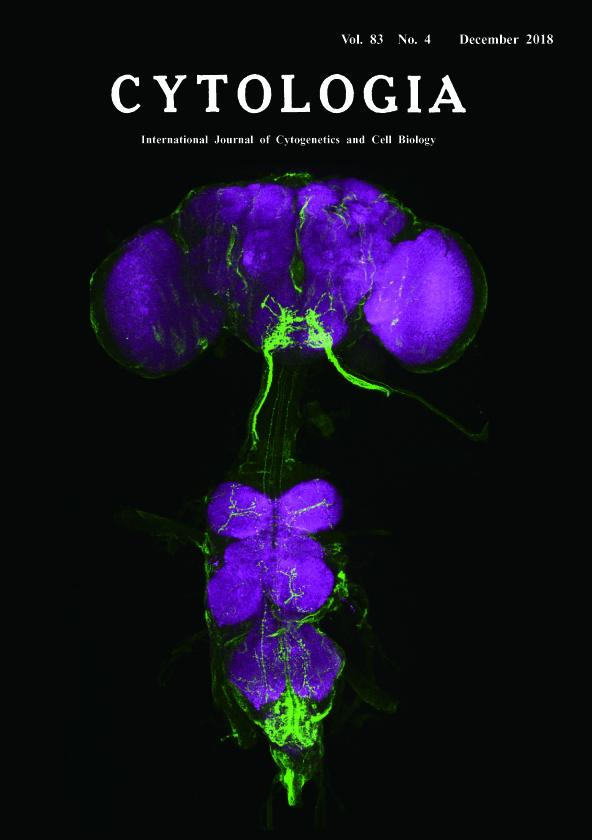| ON THE COVER |  |
|
|---|---|---|
| Vol. 83 No.4 December 2018 | ||
| Technical Note | ||
|
|
||
Analysis of Sex-Specific Regulation of the Dunce Gene in the Drosophila melanogaster Central Nervous System Dan Takase and Masataka G. Suzuki* Graduate School of Frontier Sciences, The University of Tokyo, 5–1–5 Kashiwanoha, Kashiwa, Chiba 277–8562, Japan Received October 18, 2018; accepted November 5, 2018 In Drosophila melanogaster, doublesex (dsx) encodes a sex-specific transcription factor and acts in subsets of neural and non-neural tissues to regulate behavioral and non-behavioral aspects of sexual development in males and females. However, little is known about the molecular basis for how DSX governs behavioral dimorphisms because only one known DSX target gene is involved in sexual behavior. In the present study, among 6230 putative DSX target genes identified by ChIP-seq analysis (Clough et al. 2016), we focused on the dunce (dnc) gene, which is involved in female mating behaviors (Bellen et al. 1987). Expression analysis using the dnc protein trap line demonstrated that dnc expression in the abdominal ganglion (Abg) was stronger in females than in males. This dimorphic expression disappeared in dsx mutants. These results indicated that the sexual dimorphism of DNC expression is controlled by DSX expression. To identify the region of the dnc locus through which DSX regulates DNC Abg expression, we investigated the expression of a reporter gene in the CNS using five driver lines provided by Bloomington Drosophila Stock Center: 13D02sh- LexA, 13E06-GAL4, 13F05-LexA, 13F03-GAL4 and 15B12-GAL4 (originally established by the FlyLight project. Each line contained a genomic fragment of the dnc gene). We found that only 13D02sh-LexA, which contained a fragment from dnc intron 2, had the ability to induce specific reporter expression in the female Abg. Thus, 13D02sh probably contained the enhancer sequences necessary for the female Abg expression observed with dnc. To further validate whether DNC expression in the female Abg is regulated by DSX through 13D02sh, we implemented an intersectional Flippase (FLP)-recombinase approach (Bohm et al. 2010) to visualize, specifically, neurons that express both dsx and 13D02sh-LexA. We did so by generating three cross-bred lines: 13D02sh- LexA was crossed with dsxGAL4(Δ2) (gift from Dr. Robinett), LexAop-FLP (stock number 55819, provided by Bloomington Drosophila Stock Center), and a reporter line carrying UAS>stop>Myr::GFP (stock number 55810, provided by Bloomington Drosophila Stock Center) to express membrane-bound GFP in which FLP has excised the transcriptional stop cassette (> stop >). GFP expression in the CNS of adult flies was detected by immunohistochemistry using rabbit anti-GFP antibody (1 : 1000, A-11122, Invitrogen). Neuropils were counterstained with mouse anti-nc82 antibody (1 : 30, Developmental Studies Hybridoma Bank). Confocal images were acquired using a Zeiss LSM 5 Exciter scanning microscope. The sexually dimorphic pattern of DNC expression in the Abg was relatively straightforward, with females exhibiting broader expression than males. However, more complex GFP expression was observed in Abgs: both females and males expressed GFP, but in different patterns (as shown in the cover photo). These results demonstrated that a subset of neurons in the female Abg expressed 13D02sh along with dsx, and it is therefore possible DSX regulates DNC expression in the female Abg through enhancer elements within 13D02sh. Combining this intersectional approach with an effector (such as UAS>stop>TNT and UAS>stop>dTrpA1) instead of the reporter will further clarify the role of dncexpressing neurons in the female Abg in female mating behavior.
Bellen, H. J. and Kiger, J. A. Jr. 1987. Sexual hyperactivity and reduced longevity of dunce females of Drosophila melanogaster. Genetics 115: 153–160. Bohm, R. A., Welch, W. P., Goodnight, L. K., Cox, L. W., Henry, L. G., Gunter, T. C., Bao, H. and Zhang, B. 2010. A genetic mosaic approach for neural circuit mapping in Drosophila. Proc. Natl. Acad. Sci. U.S.A. 107: 16378–16383. Clough, E., Jimenez, E., Kim, Y., Whitworth, C., Neville, M. C., Hempel, L. U., Pavlou, J. H., Chen, Z., Sturgill, D., Dale, R. K., Smith, H. E., Przytycka, T. M., Goodwin, S. F., Van Doren, M. and Oliver, B. 2014. Sex- and tissue-specific functions of Drosophila doublesex transcription factor target genes. Dev. Cell 31: 761–773. *Corresponding author, e-mail: gakyo@edu.k.u-tokyo.ac.jp DOI: 10.1508/cytologia.83.345 |
||